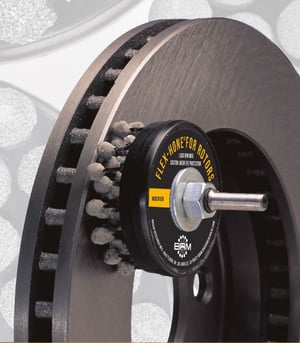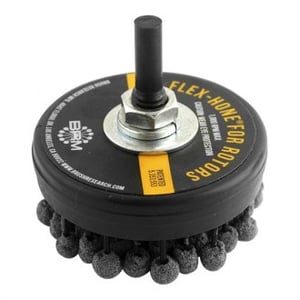 Slotted brake rotors contain machined grooves that help dissipate the heat that’s produced by braking. In racing, motorsports, and even regular driving, friction causes a layer of gas and dust to form between the brake pad and the brake rotor. Over time, this material transfer layer can impede performance.
Slotted brake rotors contain machined grooves that help dissipate the heat that’s produced by braking. In racing, motorsports, and even regular driving, friction causes a layer of gas and dust to form between the brake pad and the brake rotor. Over time, this material transfer layer can impede performance.
Slotted rotors help to reduce friction, but surface contact between pads and rotors eventually requires rotor resurfacing. For optimum brake performance, brake rotors require a non-directional or “basket weave” finish that’s free from deposits of brake pad material.
To achieve this ideal finish, a do-it-yourself (DIY) mechanic recently tried the Flex-Hone® for Rotors tool from Brush Research Manufacturing (BRM). The racer who requested the resurfacing hadn’t heard of BRM’s rotor hone before, but the mechanic who used the tool gave it a thumbs-up.
Brake Lathes, Rotor Hones, and RPMs
In a recent post at Point Me By, the racer described his mechanic's experience with using the Flex-Hone® for Rotors tool on some “slotted rotors with some schmoo on them”. The friction rings on the rotors weren’t old, but the build-up of brake pad material was significant. The racer wasn’t sure how BRM’s rotor hones would work with slotted rotors, but the mechanic gave it a try – and with great results.
First, the mechanic secured the rotor in a lathe and rotated the disc at a low speed. According to the Flex-Hone® for Rotors Brochure, a downloadable publication from BRM, the optimum lathe speed is between 125 and 210 RPM. Next, the mechanic chucked a Flex-Hone® for Rotors tool in a handheld electric drill. BRM’s brake hone is designed for use between 300 and 600 RPM – and should never be used above 1000 RPM.
Grit Sizes and More Tool Tips
 Because the build-up of brake pad material was significant, the mechanic first used a coarse-grit hone and then a medium-grit hone. At Point Me By, the racer shared the mechanic’s assessment of how “the coarse really scored the rotor up well and the medium finished it cleanly.” BRM also supplies fine-grit rotors hones for applications where a bright finish is desired.
Because the build-up of brake pad material was significant, the mechanic first used a coarse-grit hone and then a medium-grit hone. At Point Me By, the racer shared the mechanic’s assessment of how “the coarse really scored the rotor up well and the medium finished it cleanly.” BRM also supplies fine-grit rotors hones for applications where a bright finish is desired.
When using the Flex-Hone® for Rotors, light pressure is recommended. The mechanic had to apply more pressure than anticipated, but it’s dwell time against the rotor rather than excessive pressure that yields the best results. To produce the desired finish, it’s also important to use BRM’s tool in a clockwise direction for 10 to 15 seconds, and then in a counterclockwise direction for the same amount of time.
Resurfaced Rotors and More Information
As the images at Point Me By show, the resurfaced discs featured a clean, smooth basket-weave style finish for rotors that are ready for break pad bedding. “They ultimately came out great”, wrote the racer. To learn more about Flex-Hone® for Rotors tools for your next brake job, get the brochure from BRM.









